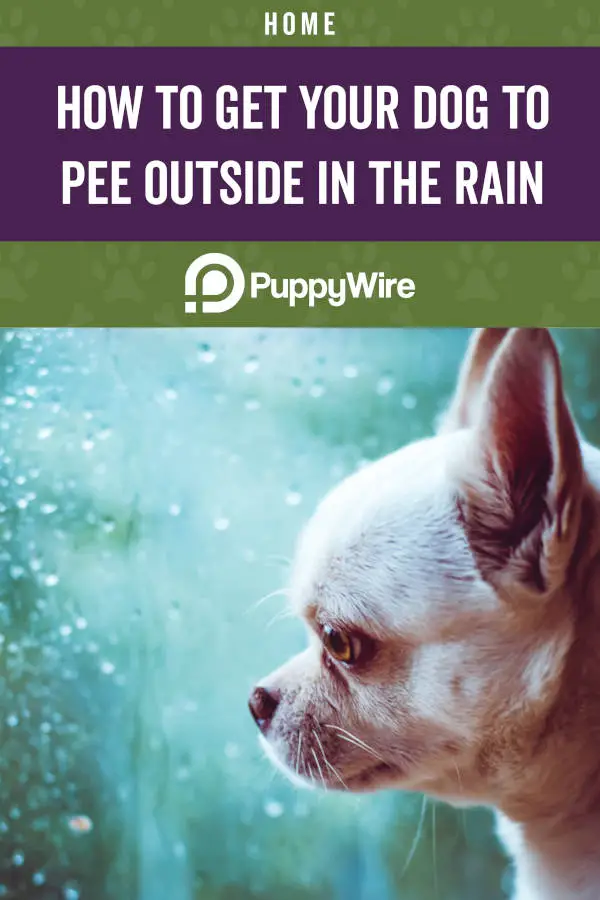How to Get Your Dog to Pee and Poop Outside When It’s Raining

If you’ve ever gotten up, gotten dressed, got your dog ready, opened the door, saw that it was windy, rainy, or snowing and your dog refused to budge, you’re not alone. Many dog owners find themselves wondering, “How to get your dog to go outside in the rain?”
This can be a frustrating problem, but there are several reasons for it and things you can try to train your dog out of this reluctance. We’re going to outline why your dog may not want to go out, tips to encourage them to go out in bad weather, and what you can do if they absolutely refuse below.
Why Some Dogs Refuse to Potty Outside in Inclement Weather
Before you go to extreme measures or haul your dog to the vet to see why they refuse to go potty in bad weather, sit back and think on it. There doesn’t have to be a medical emergency for your dog to refuse to go out, and each dog is different. Possible reasons include:
Discomfort
Making your dog go out in cold or wet conditions and their subsequent refusal to do so could simply come down to discomfort on your dog’s part. They don’t want to be wet or cold when they go to the bathroom, and they’ll let you know by refusing to go out.
You could try going out with them if you’re not because sometimes this can encourage them to go out with you. Monitor your dog and see if they have any problems going out to potty in other weather, or if it’s just wet or cold they dislike. This will tell you if it’s a comfort thing or not.
Negative Associations
Yes, it can be frustrating when your dog refuses to go out in less than ideal conditions, but scolding them or getting frustrated with them can lead to negative associations with the weather. They’ll link the bad weather with your frustration, and this can lead to accidents.
Your dog’s negative associations with the weather can cause them to go to the bathroom indoors even when you’re not actively attempting to get them outside. So, try to stay calm and tempt your dog outside in all types of weather, and go out with them to make sure they go to the bathroom.
Lack of Exposure
Maybe your dog has never been outside when it rained, stormed, or snowed, so they have no exposure to it until you want to bring them outside. Like anything new, it can be scary for them, and it can get even worse if you’re frustrated or try to force them to go out.
Instead, slowly expose your dog to these weather conditions and make it a positive and exciting experience. This way, your dog won’t have a problem with going outside in all different types of weather conditions because they know what they are and what to expect.
Our Reactions
When you go out in wet or cold weather, do you avoid puddles, snow piles, slush, or other unpleasant aspects that come with these conditions? If you take your dog out and they see this reaction over and over, they can start to mimic it and not want to go outside themselves.
Make a point to not make a big deal out of getting wet when the weather turns to soggy conditions. Take your dog out, romp in those puddles, play in that snow, and make it a fun experience that your dog can’t wait to get out and play in.
Anxiety
Many dogs get anxious when it thunders or storms, and they can start to associate this anxiety with other types of weather like rain or even a windy day. This anxiety makes your dog want to go hide and not go out in the weather at all.
Your vet can help you come up with the best route to take to help with your dog’s anxiety, and they can pinpoint the type of anxiety your dog has. They may prescribe anxiety medications, or you can work on counter training your dog to help them get over their fear.
Tips for Establishing a Potty Routine for Rainy Weather
Once you identify why your dog can’t or won’t go out when the weather is less than perfect, you can start trying ways to establish a potty routine that lasts through all different weather conditions. It may take a little time to sort through them to find the correct one, but it’s important for both of you to try.
Get Your Dog Used to Getting Wet
If you really think about it, domesticating dogs spoiled them to the point where they rarely get wet outside of bath time. Ideally, you want to get your dog used to water and getting wet from a very young age, and you could even include it in your puppy socialization routine.
You can get a small kiddy pool or even a sprinkler system with the garden hose and invite your dog to play in the water. Bring out some treats or their favorite toys and let them get used to the water on their own time. Additionally, this will help associate water and getting wet with good experiences.
Make the Potty Spot a Covered Area
You don’t have to take your dog out to a wide-open area to potty in bad weather. Instead, lead them to a covered area like a space with trees, an overhang, or you can build an area for your dog to go to the potty in.
While this won’t keep your dog completely dry in most cases, it can give the illusion that they have a safe space to go to the bathroom that will keep them mostly dry. In turn, this can help encourage them to go use it.
Feed Your Dog on Wet Grass
Many dogs don’t like the feel of wet grass under their feet, and this can make them hesitant to go out. However, it’s possible to condition your dog to love the feel of wet grass by means of positive reinforcement.
You can flood a small area of your yard with the hose and set your dog’s food bowl with some treats right in the middle of it. You can also bring out your dog’s favorite toys and play a game, so they start to associate the wet grass with food, fun, and good things.
Use a Cue to Train Your Dog
If your dog doesn’t have a cue for when they need to go to the bathroom, you can train them to potty when you say certain words. This can help your dog go potty in a variety of different weather conditions without a problem, but it takes time.
Start by taking your dog to their potty spot, and say your cue word or phrase as they begin to go to the bathroom. Once they finish, reward them for their behavior and repeat this cycle over and over until they understand your phrase means it’s time to go to the bathroom.
Wait Until Your Dog Really Has to Go
A lot of dogs go to the bathroom on a schedule around the same time each day, and it may be possible to delay your dog’s normal potty time by an hour or two, so they’re really ready to go and don’t care about the weather conditions.
However, you shouldn’t use this as your go-to method, and keep a close eye on your dog, so they don’t sneak off and have accidents in the house. For puppies or older dogs, this could also be asking for accidents because they may not have great control over their bladders.
Stimulate Your Dog by Walking
Walking stimulates your dog’s elimination system and it encourages them to go to the bathroom. Even though you may not want to go out, clip a lead on your dog and take them for a walk in the rain to help stimulate the urge to go potty.
Eventually, the walk times will shorten as your dog starts going to the bathroom sooner and sooner, just don’t give up and go inside until they go. They’ll understand that the quicker they go to the bathroom, the quicker they’ll get back where it’s dry and warm.
Bundle Up
You bundle up when you go out in icky weather, and you should consider bundling your dog up if they’re sensitive to the cold or wet conditions. You can get rain and snow jackets and booties to put on your dog before they go out, and this can help to keep them clean and dry.
Some of these raincoats simply slip over your dog’s back and buckle around their necks, so they’re easy to slip on and off in a pinch. This is especially important for dog breeds that can’t handle cold weather like Greyhounds, Chihuahuas, Boxers, Great Danes, and Terriers.
What to do if Your Dog Refuses to Potty Outside in Rainy Weather
If you try all of these tricks and your dog absolutely refuses to go out, and you don’t want to force them, there are alternatives you can consider.
- Potty Patch – You can get your dog an indoor potty patch that resembles grass over a grated catch pan. Your dog can go do their business here, you empty the pan, and rinse the entire thing out once a day to keep it clean. You can learn more about these right here.
- Puppy Pads – Laying down a puppy pad or two is a second indoor potty option you have available. However, you really have to watch these areas if you have larger dogs because they can soak through to your flooring if they go more than once.
- Litter Box – You can train a dog to potty in a litter box just like you can a cat, but this can make transitioning back outside tricky. It’s also tricky if you larger dogs in the house.
- Restrict Access – Ideally, your dog will potty on hard flooring in your home over carpeted areas because it can be difficult to get the smell out. Restrict your dog to areas of your home where it’s easier to clean up the mess and clean up any messes with enzymatic cleaners to get rid of any lingering scents.
Bottom Line
Getting your dog to potty outside in all types of weather takes patience and consistency on your part, but it’s good for your dog. Start training them young and make it an enjoyable experience, so you don’t have problems later in your dog’s life.
